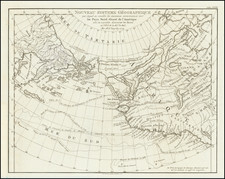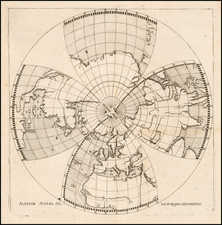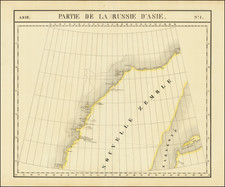First Site of Stanford's Rare Map of the Polar Regions
Fine example of Edward Stanford's map of the North Polar Regions, featuring the furthest most points reached by numerous exploring expeditions.
Published on December 2, 1878, the map notes the names and dates of explorers, from the earliest time up to Julius von Payer's Austro-Hungarian Expedition (1872-74), which resulted in the discovery of Franz-Josef Land, along with other discoveries by the same expedition in 1873.
Centered on the North Pole, Stanford's map reaches as far south as 50° North Latitude. All countries are distinguished by their own colors, and major geographic and oceanic features are labeled.
Most interesting, is the labeling of the furthest-most points of literally dozens of expeditions of discovery, along with the corresponding dates (printed in red). These extend chronologically from Sebastian Cabot's supposed visit to northern Newfoundland in 1497 to the Austro-Hungarian expedition of 1872-74. All the great names are mentioned, including Frobisher, Davis, Hudson, Baffin, Barents, Bering, Franklin, Nordenskjold, Ross and Peary, amongst many others. The amount of information featured on the map is truly extraordinary, and is unrivalled by any Arctic map of comparable size.
The map was issued Edward Stanford, then Britain's leading map publisher, in an effort to capitalize on the great contemporary interest in Polar expeditions, seen as the 'last frontier' in global exploration. Stanford had good connections with academic institutions such as the Royal Geographical Society and government bodies such as the Admiralty, so was always able to gain the most accurate information. The present map was one of Stanford's series of progressively updated maps of the Arctic Regions, the first of which was published around 1875, and the last issued in the 1930s.
Rarity
This is the first example of the 1875 edition we have seen on the market (dealer catalogs and auctions listed by Rare Book Hub) since a Francis Edwards Catalog entry in 1982.
Edward Stanford (1827-1904) was a prominent British mapmaker and publisher. A native of Holborn in the heart of London, Edward was apprenticed to a printer and stationer at the age of 14. After his first master died, he worked with several others, including Trelawny W. Saunders of Charing Cross. Saunders oversaw young Edward’s early career, ensuring that he became a Fellow of the Royal Geographical Society. Associations with the Society eventually brought Sanders much business and gave him a reputation as a publisher of explorers. As testament to this reputation, the Stanford Range in British Columbia was named for him by John Palliser.
Stanford briefly partnered with Saunders in 1852 before striking out on his own in 1853. He was an agent for the Ordnance Survey, the Admiralty, the Geological Survey, the Trigonometrical Survey of India, and the India Office. He also controlled the maps of the Society for the Diffusion of Useful Knowledge, another lucrative source of income. In 1857, Stanford founded his namesake Geographical Establishment, with Saunders and A. K. Johnston as engravers. Thereafter, Stanford was known for his “library maps”, particularly those of Africa and Asia.
Addresses and Years of Operation:
- 6 Charing Cross, London (1848): Edward Stanford's initial place of employment at Trelawney Saunders' shop.
- 7 and 8 Charing Cross, London (1853): Stanford expanded his shop to these addresses.
- 55 Charing Cross, London (1873): The shop moved to this larger location.
- 12-14 Long Acre, London (1873): Site of the new print works and current flagship store.
- 7 Mercer Walk, London (2019): Stanfords moved to this address, continuing its legacy.
Stanford's work with Chief Cartographer John Bolton, including the 1858 Library Map of Europe, positioned the company as a leader in quality cartography during a time of exploration and colonialism. Their 1862 Library Map of London earned acclaim from the Royal Geographical Society. With the business thriving, Stanford purchased Staunton & Son in 1877 and, upon retiring in 1885, handed over the reins to his son, Edward Stanford II.
As sole agents for Ordnance Survey Maps, the company's influence and reputation grew, culminating in the Stanford’s London Atlas Of Universal Geography, which was presented to Queen Victoria in 1887. The transition into the 20th century saw further integration of retail, print, and cartographic operations at Long Acre.
During World War I, Stanford's became an essential publisher for the War Office. Edward Fraser Stanford took over in 1917, steering the company through the interwar period and innovations, such as the world’s smallest maps in 1922 and the Daily Mail Motor Road Map in 1926.
Withstanding a bombing in WWII, the company continued under the stewardship of John Keith Stanford and was sold to George Philip & Son in 1947. As it adapted to the digital age, Stanfords received the Ordnance Survey Premier Partner status in 2007 and ventured into online mapping and data services.
Stanfords, now an icon for travellers and explorers, has maintained its cultural relevance and retail success well into the 21st century, underpinned by a legacy of entrepreneurial spirit and commitment to cartographic excellence.












![[ Exceptional original hand-color with highlights in gold ] Typus Aspectuum Oppositionum Et Coniunctionum Etz In Planetis](https://storage.googleapis.com/raremaps/img/small/81866.jpg)
![[Grotto of Tethys -- Versailles] Le Soleil qui se couche dans la mer / Le Globe de la Terre, divise en six parties.](https://storage.googleapis.com/raremaps/img/small/79606.jpg)


